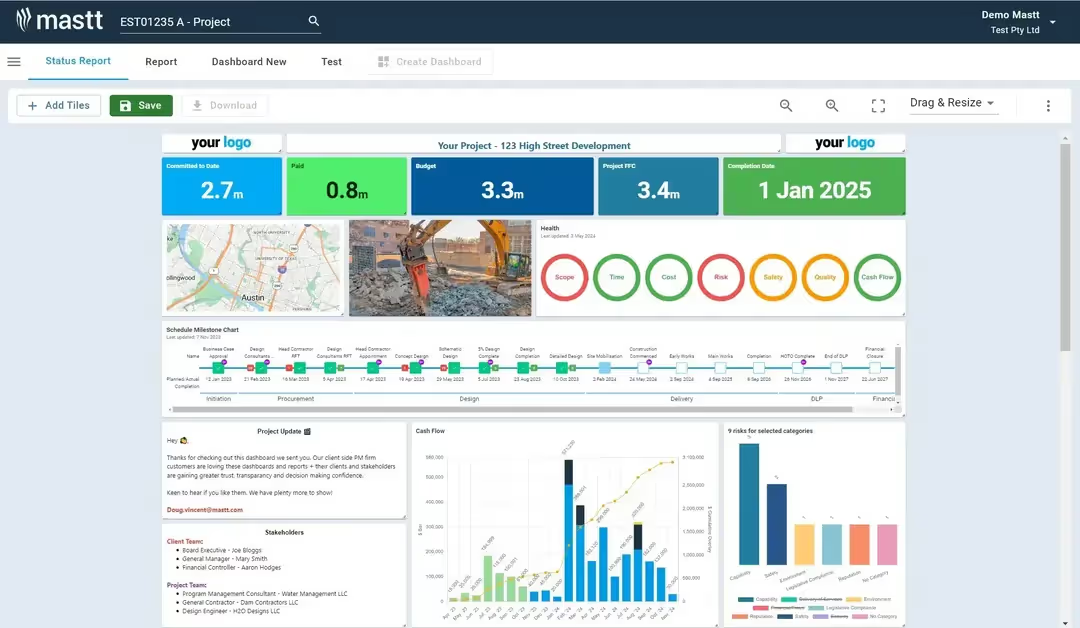There’s a lot to your construction project reporting, am I right?
Understanding the reporting process can significantly enhance project management and success for your capital project. This guide outlines the key steps in construction project reporting: Capture, Compile, Circulate, Consume, and Continuous Improvement.
Following these steps ensures that all stakeholders remain informed and that project decisions are data-driven and timely. Using the right report format and a reliable report template can streamline this process, making it easier for the entire project team to stay on track.
1. Capture
Definition and Importance
Capturing data is the first and most crucial step in construction project reporting. This involves collecting all relevant information from various sources within the project. Accurate and timely data capture lays the groundwork for informed decision-making. Without reliable data, reporting becomes ineffective.

Methods of Data Capture
- Data Collection: Gather data from site inspections, project management software, financial records, and stakeholder feedback. Comprehensive data collection is essential for creating a well-rounded report.
- Documentation: Ensure that all data is accurately documented, including progress updates, budget expenditures, timelines, and any deviations from the original plan. This can be challenging when using traditional spreadsheets, which are prone to errors and inefficiencies.
- Regular Updates: Implement a system for regular data updates to ensure the information remains current and reflects the project's status. Timely updates are crucial for maintaining the data's accuracy and relevance.
Types of Data Captured
Essential data types include:
- Progress Data: Tracking work completed and milestones achieved. This data shows how much work is done and what is left.
- Financial Data: Monitoring budgets and costs incurred. Keeping track of expenditures and budget allocations ensures financial control over the project. Often comes from downstream contractors, designers, and engineers.
- Safety Data: Documenting incidents and compliance checks. Recording safety metrics helps in maintaining a safe working environment and ensures regulatory compliance.
- Time: Schedule information from systems like Primavera or Microsoft Project.
Capturing accurate and comprehensive data lays the foundation for effective construction project reporting when we come to prepare the report, enabling informed decision-making and timely interventions.
2. Compile
Definition and Importance
Once data is captured, the next step is to compile it into a report. This step is vital for ensuring data accuracy and making the information accessible to stakeholders. Compiling data involves aggregating information from various sources, validating its accuracy, and organizing it into a cohesive format that can be easily interpreted.
Data Compilation Techniques
- Data Analysis: Analyze the collected data to identify trends, patterns, and any areas of concern. Use tools like spreadsheets, project management software, or specialized analytics tools to facilitate this process. Proper data analysis helps highlight key insights and potential issues.
- Report Structure: Organize the data into a structured format. Typical sections might include an executive summary, project status, financial overview, risk assessment, and next steps. A well-structured report format ensures stakeholders can easily find the necessary information.
- Visual Aids: Incorporate visual aids such as charts, graphs, and tables to present data clearly and concisely. Visual representations can make complex data more accessible and easier to understand for stakeholders.
- Simplifying Complex Data: Visualizations break down complex data sets into more digestible formats, helping stakeholders understand the big picture.
- Highlighting Trends and Patterns: Graphs and charts can reveal trends that might not be immediately apparent from raw data, helping teams make proactive decisions.
- Enhancing Stakeholder Engagement: Visual reports are more engaging and can help keep stakeholders interested and informed, leading to better communication and collaboration.
- Customizable Dashboards: Interactive dashboards allow stakeholders to view the specific data points they are interested in, providing a tailored view of the project's status.

- Writing Narratives: Develop clear and concise narratives to accompany the data and visual aids. These narratives should provide context, explain key findings, highlight critical issues, and offer insights that may not be immediately apparent from the raw data alone. Ensure the narrative aligns with the project's goals and speaks to the concerns of various stakeholders.
Common Project Reports
Examples of reports that get produced at this step include:
- Project Status Reports: Providing an overview of the project’s current state, including key achievements, ongoing activities, and upcoming tasks.
- Progress Reports: Detailing the work completed, current status, and upcoming tasks. This helps track the project's timeline and identify any delays.
- Financial Reports: Summarizing budget status, expenditures, and financial forecasts. These reports are crucial for financial planning and control.
Using the right report template for each type of report can greatly improve clarity and consistency, ensuring that all stakeholders receive the information in a format that is both accessible and actionable.
3. Circulate
Definition and Importance
After compiling the report, it’s essential to circulate it among the relevant stakeholders. Effective circulation ensures that all stakeholders are kept informed about the project's status and any issues that may arise. The timeliness of circulating reports is crucial because it allows stakeholders to make prompt decisions and take necessary actions without delays that could impact the project’s progress.

Methods of Circulation
- Distribution List: Identify all stakeholders needing the report, including project managers, financial officers, contractors, and other key personnel. Ensuring the right people receive the report is crucial for effective communication.
- Communication Channels: Choose the appropriate communication channels for distribution. Depending on the stakeholders' preferences, this could include email, project management platforms, or physical copies. Setting up automated distribution systems can ensure timely and consistent delivery of reports.
- Timely Distribution: It is essential to ensure that reports are circulated promptly after data compilation to keep the project on track. Delayed reports can lead to missed opportunities for intervention and decision-making.
- Regular Updates: Establishing a regular schedule for report circulation, such as weekly or monthly updates, helps stakeholders stay informed consistently, reducing the risk of surprises or last-minute changes.
- Responsive Adjustments: In addition to regular updates, responding to ad hoc reporting requests is important for addressing urgent issues as they arise.
- Feedback Mechanism: Establish a mechanism for stakeholders to provide feedback on the report. This could be through follow-up meetings, feedback forms, or digital collaboration tools. Feedback is vital for refining the reporting process.
Effective circulation ensures that all stakeholders are informed and can promptly provide input or raise concerns.
Typical stakeholders are:
- Project Managers and Supervisors: Responsible for overseeing project execution and meeting objectives.
- Clients and Investors: Interested in project progress, financial status, and overall performance.
- Internal Teams such as Finance and HR: Need detailed reports for budgeting, resource allocation, and compliance purposes.
- Regulatory Bodies: Require reports to ensure the project complies with legal and safety standards.
Giving a clear report helps stakeholders understand the information better and shows them what to look for.
4. Consume
Definition and Importance
The next step is for stakeholders to consume the report. Effective report consumption enables stakeholders to make informed decisions that can impact the project's success.

How Stakeholders Consume Reports
- Review Meetings: Schedule meetings or briefings to review the report with stakeholders. This allows for a thorough discussion of the findings and any necessary actions.
- Decision Making: Use the report as a basis for decision-making. This could involve approving budget adjustments, altering timelines, or addressing identified risks. The report should be a key tool in guiding project decisions.
- Action Plans: Develop action plans based on the report’s findings. Assign responsibilities and set deadlines to ensure that any required actions are implemented. Ensuring stakeholders thoroughly review and act on the report is critical to the project’s success.
It is important that you keep the stakeholders' interest in mind when writing a report and show data that matters most to them. That way, you're ensured that they will consume the report as you intended it to be.
5. Continuous Improvement
Finally, the reporting process should incorporate continuous improvement to enhance future reports and project management practices. This involves:
- Feedback Analysis: Analyze the feedback received from stakeholders to identify areas for improvement in the reporting process. Regularly reviewing feedback helps identify recurring issues and areas for refinement.
- Process Refinement: Based on lessons learned, refine data collection, compilation, and distribution processes. This could involve adopting new tools, improving communication channels, or training staff. Continuous refinement helps keep the reporting process efficient and effective.
- Benchmarking: Establish benchmarks and performance indicators to measure the effectiveness of the reporting process over time. Benchmarking allows teams to track improvements and ensure reporting practices evolve to meet project demands.

Looking ahead, the future of construction reporting is set to be transformed by self-service and continuous reporting platforms. These advanced systems will automate many manual tasks, provide real-time data and interactive dashboards, and enable seamless collaboration among stakeholders. With features like live data integration, predictive analytics, and automated alerts, these platforms will enhance transparency, accountability, and decision-making. Continuous improvement will be driven by automated feedback mechanisms, benchmarking, and ongoing training, ensuring that project management practices evolve and adapt for better outcomes.
Construction Project Reporting Wrap-up
A well-structured construction project reporting process—Capture, Compile, Circulate, Consume, and Continuous Improvement—ensures that all stakeholders are informed and capable of making data-driven decisions throughout a project’s lifecycle. However, to optimize this process, regular assessment and fine-tuning are essential.
Stakeholders should reflect on each step to identify potential areas of improvement. For instance, ensuring accurate data capture might involve implementing more robust data collection systems. If reports are unclear or inefficient, refining data analysis techniques or adopting better software tools could be necessary.
Timeliness and communication in report circulation are crucial, and any delays should be addressed by automating report distribution or establishing clearer channels. Effective consumption of reports should drive actionable decisions, and continuous improvement must be rooted in learning from feedback and refining processes accordingly.
By focusing on the step that poses the greatest challenge, you can significantly enhance the efficiency and effectiveness of your construction project reporting process. This will lead to better project outcomes and set the foundation for success in future projects. Utilizing the appropriate report template and consistently reviewing report examples can further support your project team in delivering clear, actionable, and impactful reports.

















